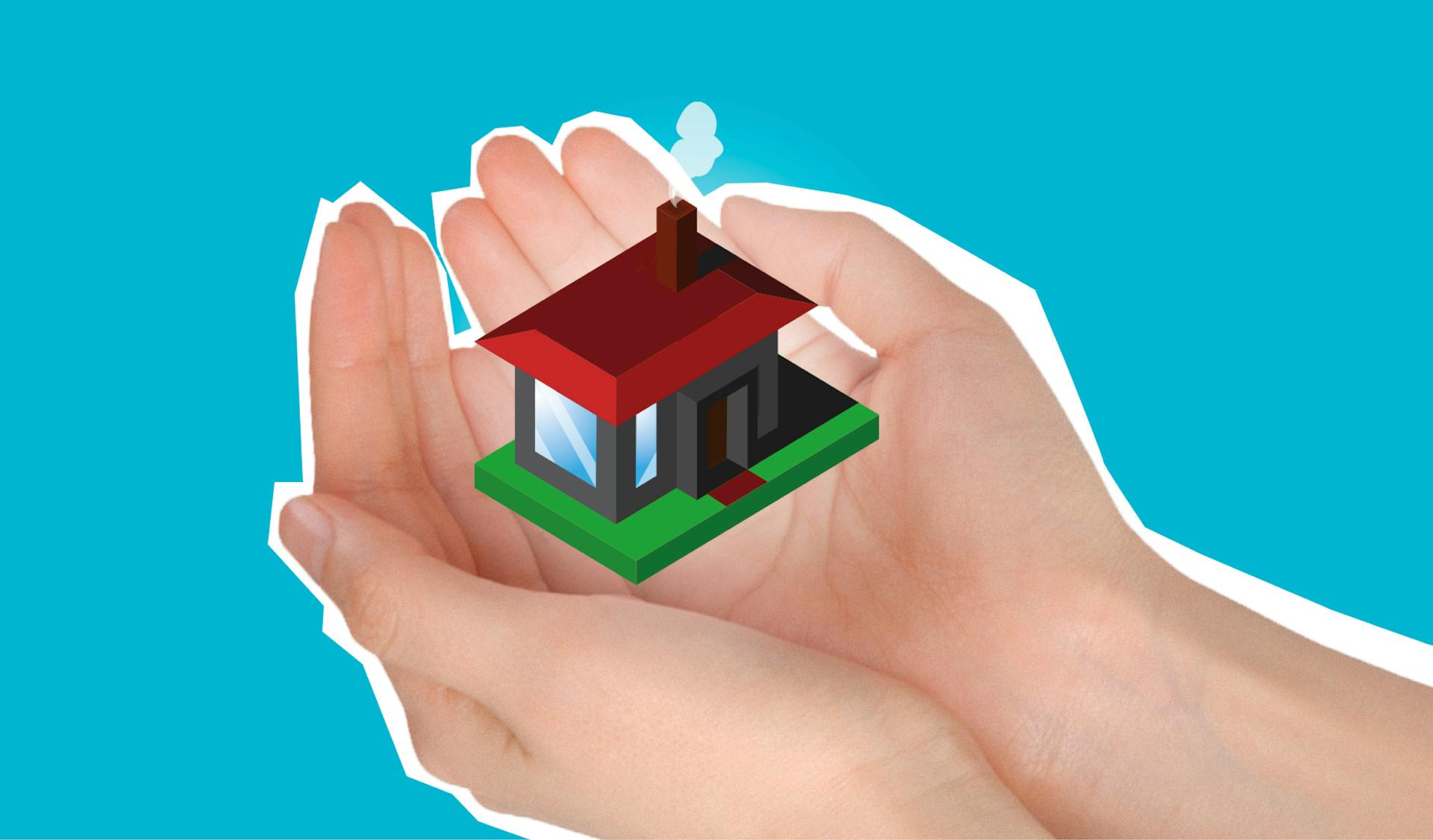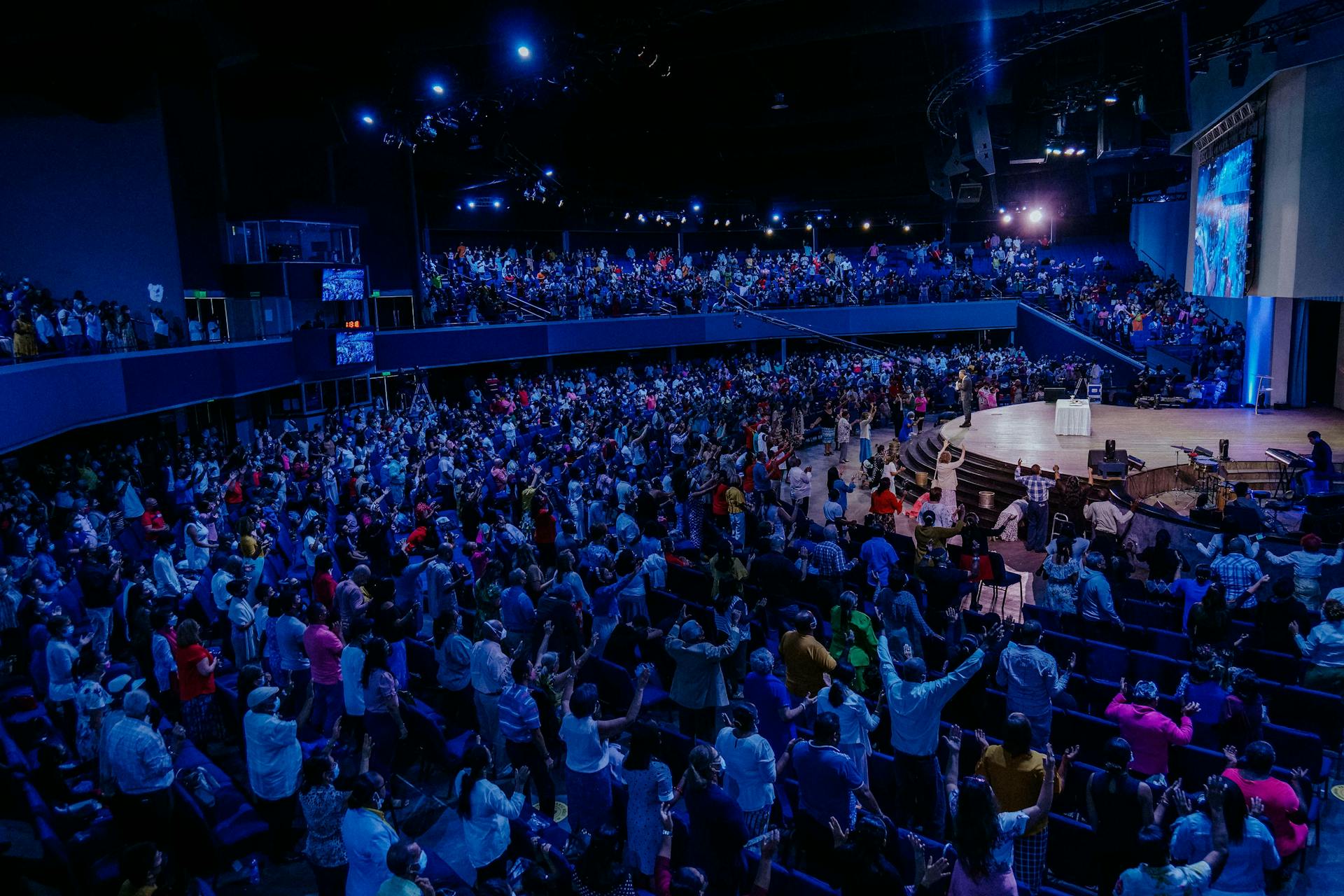
To maximize your chances of getting approved for a housing loan, it's essential to have a good credit score. Aim for a score of 700 or higher, as this will significantly improve your chances of getting approved.
A good credit score is just the beginning. You also need to have a stable income and a manageable debt-to-income ratio. This means your monthly debt payments should not exceed 36% of your gross income.
Before applying for a housing loan, check your credit report and dispute any errors that may be affecting your score. This can make a big difference in your chances of getting approved.
You might like: Is It Good Time to Refinance Your Home
Preparing for a Housing Loan
Qualifying for a home loan can be tough, especially if you have bad credit, so consider alternative borrowing options. It can be difficult to qualify for a conventional mortgage if you have bad credit.
A larger down payment can help you get approved for a home loan, as it lowers your loan-to-value ratio and reduces risk for the lender. In general, lenders like to see an LTV of 80% or less. But if you lack good credit, a larger down payment may be necessary.
Saving for a large down payment isn't easy, but tweaking your budget can make it an attainable goal.
Discover more: What You Should Know about Home Equity Lines of Credit
Make a Larger Down Payment
Making a larger down payment can significantly impact your mortgage rate and loan approval. Putting down 20% or more can lower your loan-to-value ratio to 80% or less.
This is a desirable outcome for lenders, as it reduces their risk. Lenders like to see an LTV of 80% or less.
If you put down less than 20%, you'll be required to pay private mortgage insurance (PMI), an additional monthly expense. This can add up quickly.
A larger down payment can also help you qualify for a lower interest rate. This can save you money in the long run.
Worth a look: 20 Year 2nd Mortgage Rates
Get Preapproved
Getting preapproved for a loan is a crucial step in the home buying process. Many sellers won't entertain offers from someone who hasn't already secured a preapproval.
Preapproval involves much more documentation and a hard credit check, unlike prequalification which is less formal. A preapproval will give you an idea of how much money you're approved to borrow.
You'll need to settle on a lender before getting preapproved. They'll review your finances to determine if you're eligible for funding.
Preapproval doesn't guarantee you'll get the mortgage, it's still subject to mortgage underwriting. But it's essential to know exactly how much money you're approved to borrow.
Getting preapproved will also give you an idea of what you can afford, and help you make a stronger offer on a house. This can give you a competitive edge in a crowded market.
To get preapproved, you'll need to provide financial documents to the lender. They'll use this information to determine how much they're willing to lend you.
Begin House-Hunting
Now that you have your preapproval in hand, it's time to start house-hunting.
With a preapproval, you can seriously search for a property that meets your needs and budget. It's essential to know what you're looking for and what is feasible in your price range.
Spend time examining the housing inventory and be prepared to move quickly once the house that meets your criteria goes on the market.
Discover more: Housing Loan Processing Time
Exploring Loan Options
If you have bad credit, it's not impossible to qualify for a mortgage. In fact, there are other borrowing options to consider, such as FHA loans, which require lower down payments and credit scores than most traditional mortgage loans.
You can shop around with multiple lenders to compare offers and see who is offering the lowest rate. This is especially true if you have an existing relationship with a lender, as they may offer discounts to current customers.
Consider other lenders and FHA loans, which might be a good option if you're not in a rush to improve your credit score. Some banks have programs for low-to-moderate-income borrowers, which might be part of the FHA loan program.
Here are some types of mortgages to consider:
- Conventional loans: require at least a 620 credit score and a down payment of 3 to 5 percent
- FHA loans: require a 3.5 percent down payment, a credit score of at least 580, and a DTI ratio not exceeding 43 percent
- VA loans: guaranteed by the U.S. Department of Veterans Affairs, with no down payment requirement and varying credit score requirements
- USDA loans: guaranteed by the U.S. Department of Agriculture, with no down payment requirement and varying credit score requirements
- Jumbo loans: conventional loans for properties over the federal threshold, often with higher minimum credit score and down payment requirements
Add a Cosigner
Adding a cosigner to your mortgage application can be a game-changer, especially if you're struggling to qualify due to bad credit. This can help you get approved, but keep in mind that the cosigner will be on the hook for payments if you can't make them.
The cosigner will be legally responsible for the mortgage payments, which can be a significant burden. This also means the mortgage could impact their creditworthiness and increase their debt-to-income ratio.
If you have bad credit, adding a cosigner might be a viable option, but it's essential to weigh the pros and cons. You may still be able to qualify for a home loan, but it's worth considering whether waiting until your credit improves could save you money in the long run.
First-Time Buyer Programs
First-Time Buyer Programs can be a game-changer for those looking to purchase their first home. Many states offer help to first-time home buyers, often including down payment assistance, favorable interest rates, and tax breaks.
You can find first-time home buyer programs in your state by searching online and including your state or county in your search for more localized results. Some programs are targeted geographically, while others offer help to home buyers in certain professions, such as teachers, first responders, and veterans.
For your interest: Maine State Housing Loan
First-time homebuyer programs may also offer assistance with credit requirements, allowing you to qualify for a mortgage even with poor credit. These programs often include mortgages with less-strict credit requirements than conventional lenders.
Some banks and financial institutions offer programs specifically for low-to-moderate-income borrowers, which might be part of the FHA loan program. An FHA loan is a mortgage insured by the Federal Housing Administration, which reduces banks' risk of issuing mortgage loans.
FHA loans require lower down payments and credit scores than most traditional mortgage loans, making them a more accessible option for first-time homebuyers.
Explore further: First Mortgage Loans
Shop Around with Multiple Lenders
Shopping around with multiple lenders can make a big difference in your mortgage journey. You can apply for preapproval with a few lenders to compare offers and see who is offering the lowest rate.
A good place to start is with your existing relationship with a lender, especially if they offer discounts to current customers. However, don't limit yourself to just one lender. Applying with multiple lenders gives you the opportunity to shop around and find the best deal.
Some banks have programs for low-to-moderate-income borrowers, which might be part of the FHA loan program. An FHA loan is a mortgage insured by the Federal Housing Administration, which means the FHA reduces banks' risk of issuing mortgage loans.
Here are some types of mortgages to consider:
- Conventional loans require a 620 credit score and a 3 to 5 percent down payment
- FHA loans require a 580 credit score and a 3.5 percent down payment
- VA loans are guaranteed by the U.S. Department of Veterans Affairs and have no down payment requirement, but credit score requirements vary by lender
- USDA loans are guaranteed by the U.S. Department of Agriculture and have no down payment requirement, but credit score requirements vary by lender
- Jumbo loans require a higher minimum credit score and down payment requirements
Keep in mind that interest rates and fees can vary greatly from lender to lender. It's essential to compare rates and terms to find the best option for you.
You might enjoy: Hdfc Bank Housing Loan Interest Rate
Mortgage Borrowing Limits Based on Income
Mortgage borrowing limits are determined by your income and debt level. You can borrow less than 30% of your post-tax/debt income over the mortgage term.
For example, if your post-tax/debt income is $60,000 per year, 30 years of income is $1,800,000, and 30% of that is $540,000. This figure is the total amount you'd end up paying in interest, insurance, and fees over the term, not the home value.
If this caught your attention, see: Debt to Income Ratio for Second Home
Another way to estimate it is monthly payments of less than 30% of your monthly take-home income. This rule of thumb helps you determine how much you can afford to borrow.
Here's a rough estimate of how much you can borrow based on your income:
Keep in mind that this is just a rough estimate and your actual borrowing limit may be different based on your individual circumstances. It's always best to talk to a lender for an accurate estimate of how much you'd need to make to qualify for a mortgage.
Managing Credit and Debt
Managing credit and debt is crucial when applying for a housing loan. Your credit score plays a significant role in determining the interest rate you'll qualify for and the loan options available to you.
A good credit score can help you qualify for better mortgage rates. Scores in the highest range (720-850) are considered "excellent", while scores in the 690-719 range are "good." Scores in the 630-689 range are "fair", and scores below 629 are considered "bad."
Paying your bills on time and reducing your credit card balances can help improve your credit score. You can also request free credit reports from the three major credit reporting bureaus (Experian, Equifax, and TransUnion) and dispute any errors that might be suppressing your credit score.
Your debt-to-income ratio (DTI) is another important factor lenders consider. A lower DTI is better, with lenders typically looking for a ratio of 36% or less. You can calculate your DTI by dividing your total monthly debt payments by your gross monthly income.
Here's a rough guide to help you understand your credit score:
Keep in mind that a higher credit score gets you better interest rates, while a lower score may limit your loan options. Improving your credit score and reducing your DTI can make a big difference in the mortgage application process.
Applying for a Loan
Applying for a loan can be a daunting task, but it doesn't have to be. Here are some practical tips to help you navigate the process.
You can complete most loan applications online, but it can sometimes be more efficient to apply with a loan officer in person or over the phone. This will allow you to get personalized guidance and ask questions as you go along.
To start, you'll need to gather some important documents. These typically include proof of identification, such as your driver's license and Social Security card, as well as proof of income, like paystubs and W-2s.
You'll also need to provide proof of assets, including bank statements and investment account statements. If someone is giving you a gift for your down payment, you'll need to submit a gift letter.
Here are some key documents to have ready:
- Proof of identification: driver's license, Social Security card, and/or other forms of government-issued ID
- Proof of income: paystubs, W-2s, 1099s, receipts of alimony and/or child support and rental income
- Proof of assets: bank statements, investment and/or retirement account statements, bonds, stocks, etc.
- Gift letters: if a friend or relative gives you money for a down payment
Reading lender reviews can also help you learn about the pros and cons of various lenders and customer satisfaction, providing valuable context and helping you narrow the field.
Understanding Loan Terms
Understanding Loan Terms can be a daunting task, especially if you're new to the world of mortgages. If you have bad credit, you may need to consider alternative borrowing options, such as home loans for bad credit.
The loan term is the length of time you have to repay your mortgage. This can be anywhere from 10 to 30 years, depending on your financial situation and the type of loan you choose.
Homeowners refinance their mortgages for a variety of reasons, including to lower their monthly payment or to access the equity in their property.
Here are some common loan terms to consider:
By understanding your loan terms and options, you can make informed decisions about your mortgage and achieve your financial goals.
Refinancing and Equity
Before refinancing your mortgage, it's essential to determine your reason for doing so. You might want to lower your monthly payment, lock in a lower interest rate, or access the equity in your property.
To refinance, you'll need to figure out how much equity you have in your home. Home equity is the difference between your home's market value and what you owe on your mortgage. You can estimate your equity by requesting a mortgage statement from your lender.
Most mortgage lenders won't offer a refinance loan for 100% of your equity. Typically, you need at least 20% equity left in your home after the refinance is complete. Here's a breakdown of the equity requirements for different types of loans:
Knowing how much money you need and whether you have enough equity to cover the loan amount will help you navigate the refinancing process.
Reason for Refinancing
Refinancing your mortgage can be a great way to save money or tap into the equity in your home, but it's essential to understand why you're refinancing in the first place.
There are several common reasons homeowners refinance their mortgages. To lower their monthly payment is a popular reason, allowing you to free up more money in your budget for other expenses.
To lock in a lower interest rate is another reason people refinance, which can save you thousands of dollars over the life of the loan.
Homeowners may also refinance to shorten or lengthen the loan term, which can impact the amount of interest you pay and the overall cost of the loan.
Accessing the equity in your property is another reason to refinance, which can be used for home improvements, paying off debt, or funding large purchases.
Removing private mortgage insurance (PMI) is a great reason to refinance, especially for those who put down less than 20% on their original mortgage.
Here are some common reasons homeowners refinance their mortgages:
- To lower their monthly payment
- To lock in a lower interest rate
- To shorten or lengthen the loan term
- To access the equity in the property
- To remove private mortgage insurance (PMI)
Consider Equity Availability
Most mortgage lenders won't offer a refinance loan for 100% of your equity. You typically need at least 20% equity left in your home after the refinance is complete.
Conventional and Federal Housing Administration (FHA) loans require at least 20% equity. This means that if you owe $80,000 on your mortgage, you need to have at least $16,000 in equity to qualify for a refinance.
Department of Veterans Affairs (VA) loans are more lenient, allowing you to potentially borrow a higher percentage of your home equity. However, it's still essential to know how much money you need before you apply and whether you have enough equity to cover the loan amount.
To determine your equity, request a mortgage statement from your lender to see how much mortgage principal you've paid off.
No-Closing-Cost Refinance Example
A no-closing-cost refinance sounds like a dream come true - who wouldn't want to save $4,500 in closing costs upfront? However, as we'll see, this type of refinance often comes with a higher interest rate, which can end up costing you thousands more in interest over the life of the loan. For example, if you refinance a $150,000 loan with a 30-year term and a 6% interest rate, you'll pay $173,757 in interest by the end of the loan term.
A no-closing-cost refinance example illustrates this point perfectly. With a 6.5% interest rate, you'd pay $191,317 in interest by the end of the loan term, which is a staggering $17,500 more than the original scenario. That's a significant difference, and one that's worth considering before you jump at the chance of a no-closing-cost refinance.
For your interest: How Much Do Home Equity Loans Cost
Here's a comparison of the two scenarios:
As you can see, the higher interest rate on the no-closing-cost refinance adds up to a significant amount of extra interest paid over the life of the loan. This is why it's essential to do the math and consider all the costs before making a decision.
Easy Upgrades
Your lender will typically order an appraisal to make sure your home is worth at least the amount you want to borrow.
You should be there during the appraisal to ensure the appraiser is aware of the upgrades you've made.
Make sure to give the appraiser a list of all the permanent upgrades you've made, including contractor receipts, estimates, and permits if you have them.
Every relevant upgrade to your home can potentially boost the property's appraised value, so don't be shy about pointing them out.
Your upgrades may not be readily visible to the appraiser, so it's essential to highlight them.
The more documentation you provide, the better equipped the appraiser will be to accurately assess your property's value.
Explore further: Why Is It so Humid in My House?
Sources
- https://www.nerdwallet.com/article/mortgages/how-to-get-the-best-mortgage-rate
- https://www.experian.com/blogs/ask-experian/how-to-get-a-home-loan-with-bad-credit/
- https://www.investopedia.com/articles/mortgage-real-estate/08/mortgage-application-rejected.asp
- https://www.rocketmortgage.com/learn/refinance-tips
- https://www.bankrate.com/mortgages/how-to-get-a-mortgage/
Featured Images: pexels.com


